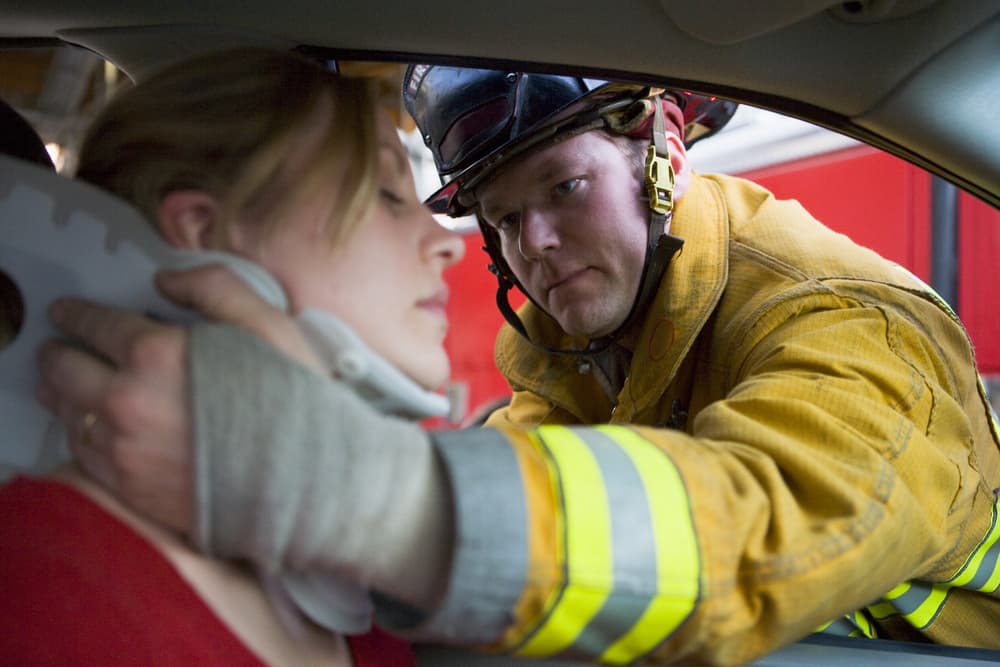When another driver operates their vehicle recklessly or carelessly, serious accidents and injuries may result. In addition to physical injuries, accident victims may experience ongoing pain, suffering, and inconvenience, for which they may be eligible to recover compensation in a personal injury claim or lawsuit.
The compensation that a car crash victim receives for their pain and suffering will depend upon various factors, including the specific accident circumstances, the nature and extent of their injuries, the amount of available insurance coverage, and the availability of favorable medical documentation and expert testimony.
A skilled car accident attorney in Chicago can file a timely personal injury claim on your behalf, negotiate with the insurance company, or litigate your case in the court system in pursuit of the pain and suffering compensation you deserve to recover.
Schedule a Free Initial Consultation Today!
Types of Car Accidents that Lead to Intense Pain and Suffering
Car accidents encompass a range of scenarios, each potentially resulting in pain and suffering for those involved. Some of the most common types of car crashes that may lead to a pain-and-suffering claim include:
- Rear-end collisions
- Side-impact collisions, also known as T-bone accidents
- Sideswipe accidents, often occurring on multi-lane roadways
- Head-on collisions
- Multi-vehicle accidents, commonly known as pile-ups
- Roll-over accidents, where a vehicle completely or partially overturns in the roadway
Understanding the diverse types of car accidents that can cause pain and suffering underscores the importance of promoting road safety and adhering to all traffic laws. However, as safe and law-abiding as you might be, other drivers can always make errors that cause you pain and suffering from a crash.
How do Car Accidents Frequently Happen?

Car accidents that lead to pain and suffering often result from a combination of factors, reflecting the complex nature of traffic incidents. Distracted driving is a leading cause, with smartphones, texting, or other distractions that may divert a driver’s attention from the road. Inattentive driving can result in collisions, leading to physical injuries and emotional distress for those involved.
Speeding is another prevalent cause of car accidents that intensify the severity of injuries and contribute to pain and suffering. Excessive speeds reduce reaction times, magnifying the effect of collisions and increasing the likelihood of severe injuries. Speed-related accidents often result in prolonged recovery periods and lasting emotional trauma for victims.
Reckless driving behaviors, including aggressive driving and tailgating, also contribute to pain and suffering in car accidents. Aggressive drivers may engage in dangerous maneuvers, such as sudden lane changes or aggressive passing, leading to high-impact collisions and substantial injuries. The aggressive nature of these accidents compounds the physical and emotional toll on https://www.illinoiscourts.gov/ victims.
Driving under the influence of alcohol or drugs remains a major factor in car accidents, causing pain and suffering. Impaired drivers often exhibit reduced coordination and impaired judgment, increasing the risk of severe accidents. Injuries resulting from accidents involving impaired drivers can be more severe, contributing to prolonged pain and emotional distress for victims.
Failure to obey traffic signals and signs is another common cause of car accidents that lead to pain and suffering. Disregarding red lights, stop signs, or other traffic regulations can result in dangerous collisions, causing injuries ranging from whiplash to more severe trauma. Victims of these accidents often endure physical pain and emotional distress due to the at-fault driver’s recklessness.
Finally, fatigued driving is a less conspicuous but impactful cause of car accidents. Drivers who are excessively tired or drowsy are more prone to lapses in attention and slower reaction times, leading to accidents causing pain and suffering. Victims of accidents involving fatigued drivers may face prolonged physical recovery and emotional challenges.
Understanding the multifaceted causes of car accidents that lead to pain and suffering emphasizes the importance of promoting responsible driving behaviors and road safety. If you recently suffered injuries in a car crash, an experienced car accident attorney can file a personal injury claim on your behalf and pursue the compensation you need for your accident-related pain, suffering, and inconvenience.
Types of Pain and Suffering Damages
Pain and suffering damages represent a significant component of compensation that car accident victims may recover, encompassing both the physical and emotional distress they experience. The nature and extent of these damages can vary, and recovering them involves a nuanced assessment of the individual's experience.
- Physical Pain – The immediate physical pain resulting from injuries sustained in a car accident is a primary component of pain and suffering damages. This includes the discomfort, agony, and limitations on daily activities resulting from fractures, sprains, lacerations, or any other physical injuries that the accident victim suffered in the crash.
- Emotional Distress – The emotional toll of a car accident is a crucial aspect of pain and suffering damages. Victims may suffer from anxiety, depression, or post-traumatic stress disorder (PTSD) due to the traumatic nature of the incident. Emotional distress can manifest as fear, sleep disturbances, and overall changes in mental well-being.
- Chronic Pain – Some car accident victims may experience ongoing or chronic pain that persists long after the initial injuries have healed. Conditions such as nerve damage or musculoskeletal issues can lead to persistent pain, affecting the individual's quality of life and daily functioning.
- Disfigurement and Scarring – Visible disfigurement or scarring resulting from car accident injuries can contribute to pain and suffering damages. Beyond the physical pain, the emotional distress associated with alterations to one's appearance, especially if permanent, can be substantial.
- Loss of Consortium – Pain and suffering damages may extend to effects on the injured accident victim’s relationships. Loss of consortium refers to the negative effects the injuries have on the victim's ability to provide companionship, support, or intimacy to their spouse or family members.
- Loss of Enjoyment of Life – Car accidents can result in diminished enjoyment of life's pleasures and activities. Pain and suffering damages may include compensation for the loss of enjoyment of hobbies, social interactions, or other aspects of life resulting from the accident victim's injuries.
- Grief and Mental Anguish – In cases where a car accident leads to the loss of a loved one, pain and suffering damages may encompass the grief and mental anguish that surviving family members experienced. The emotional toll of losing a family member in a traumatic event can be profound and warrants compensation.
- Inconvenience and Disruption – Pain and suffering damages also consider the inconveniences and disruptions that the accident caused. This may include the challenges of attending medical appointments, undergoing treatments, or adapting to a new, potentially restricted lifestyle.
Recovering pain and suffering damages requires a thorough understanding of the injured individual's unique experience and the effect of the car accident on their physical and emotional well-being. Legal professionals play a crucial role in articulating and quantifying these damages, ensuring that victims receive fair compensation for the many harmful consequences of their ordeal.
How to Prove Pain and Suffering Damages

Legally proving pain and suffering damages in a car accident claim or lawsuit involves presenting compelling evidence that demonstrates the extent and effect of the physical and emotional distress that the injured accident victim experienced. While pain and suffering damages are subjective and challenging to quantify, several key elements contribute to building a strong case, including:
- Medical Documentation – Comprehensive medical records are crucial in establishing the link between the car accident and the resulting pain and suffering. Detailed reports from healthcare professionals should outline the nature and severity of injuries, treatment plans, medications prescribed, and the expected course of recovery. These documents serve as objective evidence supporting the physical pain that the accident victim endured.
- Expert Testimony – Medical experts, such as physicians and specialists, can provide expert testimony to validate and elaborate on the extent of pain and suffering. Their professional opinions carry weight in court, helping to establish the effect of the injuries on the victim's overall well-being and quality of life.
- Mental Health Records – If the victim has experienced emotional distress, anxiety, depression, or post-traumatic stress disorder (PTSD) following their car accident, mental health records become critical. Psychologists, psychiatrists, or therapists can provide expert opinions on the emotional toll and ongoing mental health challenges that the accident victim faces.
- Witness Testimony – Eyewitness accounts can contribute to proving pain and suffering damages. Witnesses who observed the immediate aftermath of the accident or the victim's struggles during recovery can provide firsthand testimony regarding the visible signs of distress, pain, and emotional anguish.
- Personal Testimony – The accident victim's own testimony is a powerful tool in conveying the subjective experience of pain and suffering. Sharing personal narratives about the challenges faced, the effect on daily life, and the emotional toll of the accident provides a human perspective that resonates with judges and juries.
- Photographic and Video Evidence – Visual documentation, such as photographs or videos, can illustrate the visible injuries, scars, or physical limitations from the car accident. These visuals strengthen the case by providing tangible evidence of the pain and suffering that the accident victim endured.
- Daily Activity Logs – Keeping detailed logs of daily activities, limitations, and challenges faced during recovery can be beneficial. These logs record the ongoing effect of injuries on the accident victim's life, providing insight into their daily struggles and changes in their lifestyle.
- Comparison of Before and After – Establishing a comparison between the accident victim's life before and after the car accident is a compelling way to demonstrate the changes the injuries brought about. Testimonies, photographs, or other evidence showing the contrast in the victim's capabilities, activities, and overall well-being are persuasive in illustrating the effects of pain and suffering.
Successfully proving pain and suffering damages requires a comprehensive approach combining medical evidence, expert testimony, and the accident victim's narrative.
An experienced personal injury attorney can navigate the legal complexities for you, present a compelling case, and maximize your chances of obtaining fair compensation for your accident-related losses.
Factors that May Affect the Total Amount of Your Pain and Suffering Compensation
Several factors can influence the amount of compensation a person may recover for pain and suffering in a car accident. The severity of injuries is a primary consideration. More severe injuries typically result in a higher compensation amount, reflecting the increased physical and emotional effects on the accident victim's life.
Medical evidence also plays a crucial role in determining compensation for pain and suffering. Comprehensive documentation of injuries, treatment plans, and expert medical opinions helps establish the extent of the victim's suffering. Clear and compelling evidence enhances the claim's credibility and strengthens the case for higher compensation.
The duration of recovery is another factor affecting compensation. Longer recovery periods often correlate with increased pain and suffering, which may be a part of the compensation recovered. Chronic pain or long-term disabilities resulting from the accident may warrant higher compensation amounts to address the ongoing effect on the victim's life.
The overall effect on daily activities and quality of life is also important when determining appropriate compensation for an accident victim’s pain and suffering. If the injuries significantly restrict the victim's ability to engage in hobbies, work, or other daily activities, it may contribute to a higher compensation amount. Emotional distress, anxiety, or post-traumatic stress resulting from the accident can also influence the compensation the accident victim receives.
Available insurance policy limits will also affect the recoverable compensation amount. If the at-fault party's insurance policy has lower limits, it may limit the overall compensation available. In such cases, exploring additional avenues, such as underinsured motorist coverage or pursuing legal action against the at-fault party personally, may be necessary to secure fair compensation.
Each car accident case is unique, and the interplay of these factors varies. A knowledgeable car accident attorney can build a strong case on your behalf and pursue the maximum compensation for pain and suffering based on your unique circumstances.
Call a Car Accident Attorney about Your Case Right Away
If you have suffered or continue to suffer pain and suffering due to your car accident injuries, you need to consult a knowledgeable personal injury attorney in your jurisdiction as quickly as possible. Your attorney can determine your eligibility for pain-and-suffering compensation and will do everything possible to maximize the settlement or litigation award you receive.



